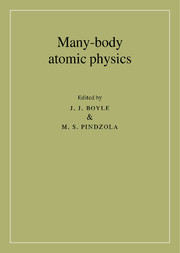Book contents
- Front Matter
- Contents
- Foreword
- Contributors
- Preface
- Acknowledgements
- Part 1 ATOMIC STRUCTURE
- Part 2 PHOTOIONIZATION OF ATOMS
- Part 3 ATOMIC SCATTERING: A. General Considerations
- Part 3 ATOMIC SCATTERING: B. Low-order applications
- 10 Perturbation series methods for calculating electron-atom differential cross sections
- 11 Target dependence of the triply differential cross section for low energy (e, 2e) processes
- 12 Overview of Thomas processes for fast mass transfer
- Part 3 ATOMIC SCATTERING: C. All-order applications
- Appendix: Units and notation
- References
- Index
12 - Overview of Thomas processes for fast mass transfer
Published online by Cambridge University Press: 22 September 2009
- Front Matter
- Contents
- Foreword
- Contributors
- Preface
- Acknowledgements
- Part 1 ATOMIC STRUCTURE
- Part 2 PHOTOIONIZATION OF ATOMS
- Part 3 ATOMIC SCATTERING: A. General Considerations
- Part 3 ATOMIC SCATTERING: B. Low-order applications
- 10 Perturbation series methods for calculating electron-atom differential cross sections
- 11 Target dependence of the triply differential cross section for low energy (e, 2e) processes
- 12 Overview of Thomas processes for fast mass transfer
- Part 3 ATOMIC SCATTERING: C. All-order applications
- Appendix: Units and notation
- References
- Index
Summary
Introduction
Transfer of mass is a quasi-forbidden process. It does not occur very simply. So new insights into how masses interact in our environment may be discovered by considering this challenging little puzzle of how a quasi-forbidden process operates. The simple pickup of a stationary mass, M2, by a moving mass, M1, is forbidden by conservation of energy and momentum. Specifically, if M1 < M2 then M1 rebounds, if M1 = M2 then M1 stops and M2 continues on, and if M1 > M2 then M2 leaves faster than M1. In none of these cases do M1 and M2 leave together. Thus, mass transfer may not occur in a single elastic collision. L.H. Thomas understood this in 1927 and further realized that transfer of mass occurs only when a third mass is present and all three masses interact. The simplest allowable process is a two-step process now called a Thomas process. It was not until the work of Shakeshaft and Spruch 52 years later that the significance of Thomas processes was properly understood. There is evidence, for example, that Bohr did not understand the significance of the failure of the first Born approximation to reduce to the correct classical limit.
The resolution of Bohr's dilemma lies in the unusual feature that the second Born term for mass transfer is larger than the first Born term at high collision velocity, v.
- Type
- Chapter
- Information
- Many-Body Atomic Physics , pp. 287 - 302Publisher: Cambridge University PressPrint publication year: 1998

